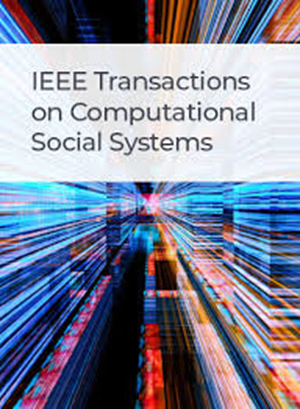音乐对焦虑、抑郁和创伤后应激障碍患者压力水平的影响:混合效应模型和倾向评分分析
IF 4.5
2区 计算机科学
Q1 COMPUTER SCIENCE, CYBERNETICS
IEEE Transactions on Computational Social Systems
Pub Date : 2025-06-17
DOI:10.1109/TCSS.2025.3561073
引用次数: 0
摘要
音乐和心理健康的交集越来越受到关注,之前的研究强调了音乐减轻压力和焦虑的潜力。尽管有这些有希望的发现,但许多研究受到小样本和传统观察方法的限制,在我们对音乐对心理健康的广泛影响的理解上留下了空白。针对这些局限性,本研究引入了一种新的方法,将广义线性混合模型(GLMM)与倾向得分匹配(PSM)相结合,探索被诊断为焦虑、抑郁和创伤后应激障碍(PTSD)的社交媒体用户听音乐与压力水平之间的关系。我们的研究不仅确定了听音乐和压力之间的关联模式,而且考虑到教育水平、性别和年龄等人口因素,对潜在的因果关系进行了更严格的检查。我们的研究结果显示,在所有的心理健康状况中,听音乐与压力水平的降低显著相关,观察到焦虑降低21.3%,抑郁降低15.4%,创伤后应激障碍降低19.3%。此外,听音乐的用户更有可能报告压力得分为零,这表明放松效果更强。此外,我们对人口统计学变化的分析表明,年龄和教育水平会影响音乐对减轻压力的影响,这突出了个性化干预的潜力。这些发现有助于更深入地了解音乐的治疗潜力,特别是在为不同人群的不同需求量身定制干预措施方面。本文章由计算机程序翻译,如有差异,请以英文原文为准。
The Impact of Listening to Music on Stress Level for Anxiety, Depression, and PTSD: Mixed-Effect Models and Propensity Score Analysis
The intersection of music and mental health has gained increasing attention, with previous studies highlighting music’s potential to reduce stress and anxiety. Despite these promising findings, many of these studies are limited by small sample sizes and traditional observational methods, leaving a gap in our understanding of music’s broader impact on mental health. In response to these limitations, this study introduces a novel approach that combines generalized linear mixed models (GLMM) with propensity score matching (PSM) to explore the relationship between music listening and stress levels among social media users diagnosed with anxiety, depression, and posttraumatic stress disorder (PTSD). Our research not only identifies associative patterns between music listening and stress but also provides a more rigorous examination of potential causal effects, taking into account demographic factors such as education level, gender, and age. Our findings reveal that across all mental health conditions, music listening is significantly associated with reduced stress levels, with an observed 21.3% reduction for anxiety, 15.4% for depression, and 19.3% for PTSD. Additionally, users who listened to music were more likely to report a zero stress score, indicating a stronger relaxation effect. Further, our analysis of demographic variations shows that age and education level influence the impact of music on stress reduction, highlighting the potential for personalized interventions. These findings contribute to a deeper understanding of music’s therapeutic potential, particularly in crafting interventions tailored to the diverse needs of different populations.
求助全文
通过发布文献求助,成功后即可免费获取论文全文。
去求助
来源期刊

IEEE Transactions on Computational Social Systems
Social Sciences-Social Sciences (miscellaneous)
CiteScore
10.00
自引率
20.00%
发文量
316
期刊介绍:
IEEE Transactions on Computational Social Systems focuses on such topics as modeling, simulation, analysis and understanding of social systems from the quantitative and/or computational perspective. "Systems" include man-man, man-machine and machine-machine organizations and adversarial situations as well as social media structures and their dynamics. More specifically, the proposed transactions publishes articles on modeling the dynamics of social systems, methodologies for incorporating and representing socio-cultural and behavioral aspects in computational modeling, analysis of social system behavior and structure, and paradigms for social systems modeling and simulation. The journal also features articles on social network dynamics, social intelligence and cognition, social systems design and architectures, socio-cultural modeling and representation, and computational behavior modeling, and their applications.
 求助内容:
求助内容: 应助结果提醒方式:
应助结果提醒方式:


